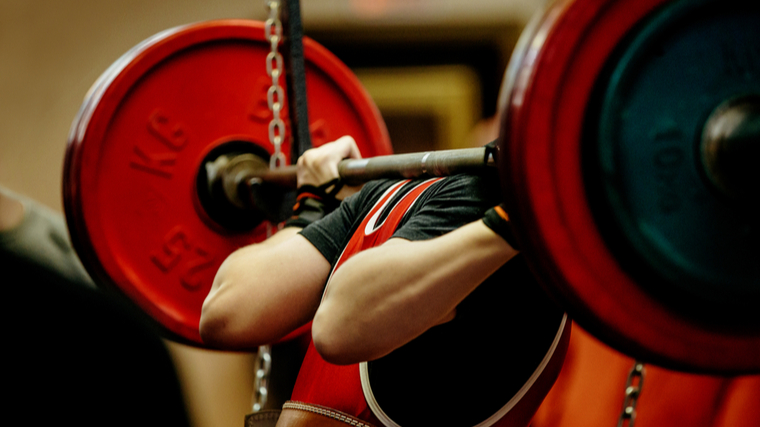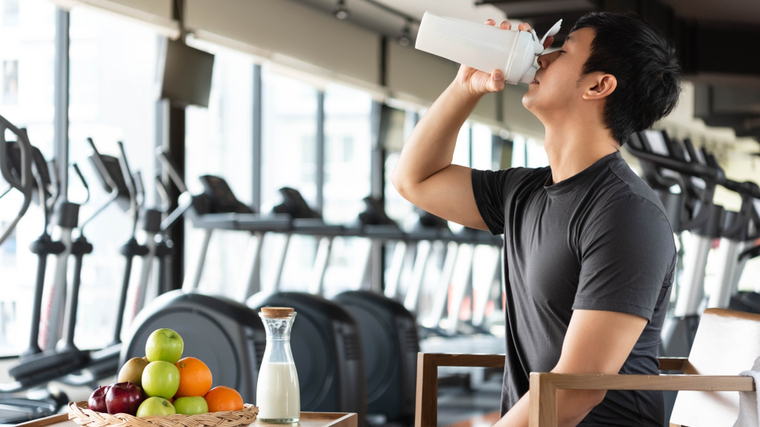You do everything your coach tells you to do. You’re working out three or four times a week; you’re going on long walks on your active recovery days; you’re actually eating fruit and veggies every single day. And still… there’s that one part of your body that you flinch at when you glance in a mirror.
It’s not surprising that many people want to change their “problem” areas when body image issues are so common throughout society. How could you not feel some kind of way about your body after scrolling through carefully-manipulated images on Instagram and checking out the bodies of people whose entire career is training? But if you’ve stumbled on the pervasive idea of “spot fat reduction” as a way to get rid of your belly fat, you might want to think again.

Of all the fat loss myths out there, spot fat reduction — or just spot reduction — persists as chief among them. Science says it just doesn’t work like that, but athletes still hope it will. Figuring out exactly what the idea behind spot fat reduction is — and learning why it is a myth — can help you adjust your training to actually help get your body closer to where you want it to be.
Editor’s note: The content on BarBend is meant to be informative in nature, but it shouldn’t take the place of advice and/or supervision from a medical professional. The opinions and articles on this site are not intended for use as diagnosis, prevention, and/or treatment of health problems. Speak with your physician if you have any concerns.
What is Spot Fat Reduction?
Spot fat reduction is a form of training that focuses on reducing subcutaneous fat in a particular part of your body. The logic is that by emphasizing a certain body part during your workout, you’ll encourage fat loss in that particular area.
For example, people may perform seemingly endless Russian twists and side planks if they’re not happy with the sides of their torso or hips. Or, an athlete might focus almost exclusively on bench presses and dumbbell flyes if they’re looking to reduce the size of their breasts.
Does Spot Fat Reduction Actually Work?
There really isn’t a way around it — resistance training doesn’t produce spot reduction. (1)(2) Although you can’t lose body fat around your abdominals with crunches alone, supplementing cardio-based circuit training with core exercises might help reduce belly fat. (3) This makes sense, as core-specific exercises alone don’t provide enough exercise intensity to create the calorie deficit that you need to lose weight. Adding cardio-based circuits to core training can, however, contribute to creating that deficit.

When someone has a goal of losing belly fat and follows an intense exercise program that includes core training, it’s tempting to conclude that this is, indeed, spot reduction. People lose body fat at different rates from different areas. If those areas happen to be the ones someone was hoping to lose fat from, then yes — it might look like spot fat reduction at a glance. But research has shown that, for example, performing extra triceps exercises in the hopes of spot reducing fat from your upper arms doesn’t work. (3)
Even if a training program is effective at reducing overall fat mass, emphasizing a particular part of your body won’t make you lose more fat there. (4) In a study where participants trained their non-dominant leg three times a week for 12 weeks, overall fat mass went down — but there wasn’t a difference between their two legs. (4)
So is Body Part-Specific Training a Waste of Time?
All that abdominal training certainly doesn’t go to waste. Even though focusing solely on core workouts won’t reduce body fat around your abs, it can significantly increase your abdominal muscle endurance. (5) That’s very important if you’re interested in performing heavy compound lifts like squats, deadlifts, and overhead presses. Core strength and endurance are huge contributors to being able to lift heavy and often. Lifting heavy weights can, in turn, help you lose body fat overall if that is, indeed, one of your goals.

The same logic applies to training, say, your triceps or glutes. Spot reduction won’t work, but you will still strengthen key areas of your body that can help you lift more effectively. Strong triceps, for example, are crucial for locking out heavy lifts like the bench press and overhead press. And you need powerful glutes for everything from squats and deadlifts to climbing all those stairs to get to your fifth-floor walk-up apartment.
Why Doesn’t Spot Fat Reduction Work?
Focusing on specific muscle groups in training can certainly encourage localized muscle growth. That’s because lifting weights requires your muscles to perform a certain amount of work that — if you’re eating enough food and giving them proper training stimuli — leads your muscles to grow. But as much as you might want it to, localized muscle growth does not lead to localized fat loss. Here’s why.
Science of Fat Loss
The idea behind spot reduction is to make particular muscles work extra hard. You might be searching for that “burn” you feel when you’re doing endless triceps extensions, for example. But that burn is squarely located in your muscles — it’s just your muscles working hard, not fat burning. Because technically, fat doesn’t burn. It oxidizes, which means it gets broken down so you can use it for energy.
And while exercise can increase the oxidation of fatty acids for energy, those fatty acids come from your bloodstream. Along with your blood flow, these soon-to-be oxidized fatty acids flow toward the muscles that need them during your workout — but they don’t necessarily come from the area you’re training. So exercise might contribute to general fat loss, but you can’t really control where those oxidized fatty acids originate from.

Improving your overall circulation through full-body endurance exercise is a more effective way to oxidize fatty acids than working out one body part. (6) Fat loss doesn’t happen in a discrete part of your body where you’d like to reduce fat levels. It happens in your bloodstream when your body needs fuel.
Ineffective Training Strategy
It’s not a coincidence that in cases where it looks like spot fat reduction is working, the athlete is performing both extensive core exercises and intensive full-body circuit training. (3) However, when athletes just perform core training (for example), they’re not providing enough training stimulus to drive general body fat loss through exercise, let alone specific fat loss in a particular location.
Only training one part of your body with isolation moves like crunches or Pallof presses won’t really make a dent in how many calories you take in versus how many you use. Higher energy activities like circuit training or low-intensity, full-body activities like taking long walks will more effectively impact your caloric burn.
However, if you’ve decided to exercise to elicit a caloric deficit, make sure you’re striking a steady balance. You need to eat enough to maintain your energy through tough workouts or long walks while also using more energy (AKA, calories) than you take in.
How Fat Loss Actually Works
You need to be use more energy (AKA, calories) than you take in to burn fat. When this happens, your body needs to break down triglycerides — a type of fat in your body made up of three fatty acids. These triglycerides get stored in your body when you don’t use fat as energy right away. It’s healthy and necessary for everyone to have triglycerides — AKA, fat — stored in their body. They help maintain cognitive function and baseline energy levels. (7) At the same time, it’s helpful to make sure your triglyceride levels aren’t so high as to interfere with your heart function and cardiovascular system. (8)

When you need to use them as energy, triglycerides break down into fatty acids. In turn, those fatty acids are transported throughout your body in your bloodstream. They break down even further and deliver energy to your muscles. (6)
To facilitate this process, you need protein, carbohydrates, and fat in your body. (6) In fact, research suggests that eating more dietary fat helps tell your body to oxidize more fat for energy. (9)
As for why you can’t seem to lose that “stubborn” area of body fat, research suggests that effective long-term fat loss is all about consistency and finding a nutrition and exercise routine that is sustainable for you. (10)(11)(12)(13) Your hormones and other factors — including genetics — help determine the rate and location from which you lose fat faster. (14)(15)(16) Patience and consistency with your routine seem to be key for reducing body fat in those stubborn areas. (10)(11)(12)(13)
Alternatives to Spot Fat Reduction
If one of your goals is to lose weight in a certain body part, spot reduction just won’t do it for you. But that doesn’t mean there aren’t other ways to get yourself closer to where you want to be.
Find Movement You Enjoy
Your old college roommate might swear by high-intensity interval training (HIIT) because those were the kinds of workouts that helped them lose weight. But if the idea of box jumps and burpees makes you never want to get off your couch, then rest assured — you do not ever have to do box jumps or burpees.
Research has shown that the best way to stay consistent with an exercise routine is to enjoy what you’re doing. (17)(18)(19) Instead of forcing yourself to perform workouts you hate, find a mode of movement that you love and try to stick to that. Maybe that means taking your dog out for longer walks, or maybe it means learning how to be a powerlifter.

When you like the way you’re exercising, you start doing it because it’s fun rather than because you feel obligated to do so for a weight loss goal. When you genuinely like physical activity — instead of forcing yourself through traditional exercises you hate — you’re better able to stick with it. (18)
Sticking with it helps you lose weight in a sustainable way. It’s been found that consistency over time is the most effective way to sustainably change your body composition. (11)(12)(13) Experimenting to find a type of exercise you truly love will go a long way, no matter what your goals are.
Lift Heavy Weights
It’s tempting to only work out the specific area of your body that you want to change. But big full-body movements have a better chance of changing your body. Since spot reduction isn’t actually a thing, lifting heavy weights with compound exercises is a great bet for strengthening your entire body.
Forging a stronger and more muscular body lets you show off your muscles. The stronger you get, the more enjoyable your exercise program becomes — and the easier it’ll be to stick to it. (19) And sticking to it helps you lose weight in the long-term. (11)(12)(13)

Exercises that involve your whole body require more energy than moves like planks or glute bridges. When you use more energy, you can more easily create the caloric deficit you might want if you’re looking to lose weight.
But make sure you’re striking a careful balance. If you’re lifting heavy, you need to fuel your body so that you can safely maintain the energy you need to move big loads. You can lose body fat and gain muscle at the same time, but — perhaps ironically — you have to eat enough food to be able to do so.
Explore Sustainable Nutrition Practices
Your nutrition habits tend to last over time if they’re sustainable for you emotionally and physically. Popular practices your gym buddies might talk about, like cutting weight or carb cycling, are not meant to last more than a few weeks at a time. They’re supposed to produce temporary changes in your body and aren’t sustainable long-term.
On the other hand, being consistent with your nutrition over time is more effective than restricting what you eat. (11)(12)(13) Nutrition plans aimed at weight loss have to be sustainable to be effective in the long term. Studies have found that sustainable practices like intuitive eating can help people lose weight and not gain it back over long periods of time. (11)(12)(13)(20)(21)

Ultimately, fat loss can happen if your body is using more energy than it’s taking in. But keeping yourself in a state of perpetual caloric deficit can damage the messages your food-related hormones give you. (22) When you’re chronically dieting, your body will send you chemical signals that you’re starving even when you have plenty of food. (23) So when your goal is losing body fat, pay extra attention to your psychological and emotional relationship with food to keep yourself healthy overall.
Spot the Myth
If you’re reading this because you’re holding out hope for spot fat reduction, alas — science says that spot reduction doesn’t work. Exercising the muscles in the area you want to change just doesn’t speed up fat loss there.
For reasons that you generally can’t control (think: hormones and genetics), you’ll lose body fat from different areas and at different rates than other people. Sometimes, it’ll “look” like spot reduction if the way your body is losing fat happens to align with your goals. But that doesn’t make spot reduction an actual thing that you can control.
Instead, try to find fat loss strategies that feel good for your body and mind. When your goal is fat loss, shift your focus to the bigger picture — and the bigger picture is all about sustainability and enjoyment that allow you to be consistent.
References
- Kostek MA, Pescatello LS, Seip RL, Angelopoulos TJ, Clarkson PM, Gordon PM, Moyna NM, Visich PS, Zoeller RF, Thompson PD, Hoffman EP, Price TB. Subcutaneous fat alterations resulting from an upper-body resistance training program. Med Sci Sports Exerc. 2007 Jul;39(7):1177-85.
- Kuo CH, Harris MB. Abdominal fat reducing outcome of exercise training: fat burning or hydrocarbon source redistribution? Can J Physiol Pharmacol. 2016 Jul;94(7):695-8. doi: 10.1139/cjpp-2015-0425. Epub 2016 Mar 5.
- Paoli, A., Casolo, A., Saoncella, M., Bertaggia, C., Fantin, M., Bianco, A., Marcolin, G., & Moro, T. (2021). Effect of an Endurance and Strength Mixed Circuit Training on Regional Fat Thickness: The Quest for the “Spot Reduction”. International journal of environmental research and public health, 18(7), 3845.
- Ramírez-Campillo R, Andrade DC, Campos-Jara C, Henríquez-Olguín C, Alvarez-Lepín C, Izquierdo M. Regional fat changes induced by localized muscle endurance resistance training. J Strength Cond Res. 2013 Aug;27(8):2219-24.
- Vispute SS, Smith JD, LeCheminant JD, Hurley KS. The effect of abdominal exercise on abdominal fat. J Strength Cond Res. 2011 Sep;25(9):2559-64.
- Purdom, T., Kravitz, L., Dokladny, K., & Mermier, C. (2018). Understanding the factors that effect maximal fat oxidation. Journal of the International Society of Sports Nutrition, 15, 3.
- Yin ZX, Shi XM, Kraus VB, Fitzgerald SM, Qian HZ, Xu JW, Zhai Y, Sereny MD, Zeng Y. High normal plasma triglycerides are associated with preserved cognitive function in Chinese oldest-old. Age Ageing. 2012 Sep;41(5):600-6.
- Yin ZX, Shi XM, Kraus VB, Fitzgerald SM, Qian HZ, Xu JW, Zhai Y, Sereny MD, Zeng Y. High normal plasma triglycerides are associated with preserved cognitive function in Chinese oldest-old. Age Ageing. 2012 Sep;41(5):600-6.
- Leckey JJ, Hoffman NJ, Parr EB, Devlin BL, Trewin AJ, Stepto NK, Morton JP, Burke LM, Hawley JA. High dietary fat intake increases fat oxidation and reduces skeletal muscle mitochondrial respiration in trained humans. FASEB J. 2018 Jun;32(6):2979-2991.
- Schumacher LM, Thomas JG, Raynor HA, Rhodes RE, O’Leary KC, Wing RR, Bond DS. Relationship of Consistency in Timing of Exercise Performance and Exercise Levels Among Successful Weight Loss Maintainers. Obesity (Silver Spring). 2019 Aug;27(8):1285-1291.
- Tylka TL, Calogero RM, Daníelsdóttir S. Intuitive eating is connected to self-reported weight stability in community women and men. Eat Disord. 2020 May-Jun;28(3):256-264.
- Warren JM, Smith N, Ashwell M. A structured literature review on the role of mindfulness, mindful eating and intuitive eating in changing eating behaviours: effectiveness and associated potential mechanisms. Nutr Res Rev. 2017 Dec;30(2):272-283.
- Camilleri GM, Méjean C, Bellisle F, Andreeva VA, Kesse-Guyot E, Hercberg S, Péneau S. Intuitive eating is inversely associated with body weight status in the general population-based NutriNet-Santé study. Obesity (Silver Spring). 2016 May;24(5):1154-61.
- Christensen, P., Meinert Larsen, T., Westerterp-Plantenga, M., Macdonald, I., Martinez, J. A., Handjiev, S., Poppitt, S., Hansen, S., Ritz, C., Astrup, A., Pastor-Sanz, L., Sandø-Pedersen, F., Pietiläinen, K. H., Sundvall, J., Drummen, M., Taylor, M. A., Navas-Carretero, S., Handjieva-Darlenska, T., Brodie, S., Silvestre, M. P., … Raben, A. (2018). Men and women respond differently to rapid weight loss: Metabolic outcomes of a multi-centre intervention study after a low-energy diet in 2500 overweight, individuals with pre-diabetes (PREVIEW). Diabetes, obesity & metabolism, 20(12), 2840–2851.
- Schleinitz D, Böttcher Y, Blüher M, Kovacs P. The genetics of fat distribution. Diabetologia. 2014 Jul;57(7):1276-86.
- Cha S, Kang JH, Lee JH, Kim J, Kim H, Yang YJ, Park WY, Kim J. Impact of Genetic Variants on the Individual Potential for Body Fat Loss. Nutrients. 2018 Feb 26;10(3):266.
- Hagberg LA, Lindahl B, Nyberg L, Hellénius ML. Importance of enjoyment when promoting physical exercise. Scand J Med Sci Sports. 2009 Oct;19(5):740-7.
- Lakicevic, N., Gentile, A., Mehrabi, S., Cassar, S., Parker, K., Roklicer, R., Bianco, A., & Drid, P. (2020). Make Fitness Fun: Could Novelty Be the Key Determinant for Physical Activity Adherence?. Frontiers in psychology, 11, 577522.
- Heisz, J. J., Tejada, M. G., Paolucci, E. M., & Muir, C. (2016). Enjoyment for High-Intensity Interval Exercise Increases during the First Six Weeks of Training: Implications for Promoting Exercise Adherence in Sedentary Adults. PloS one, 11(12), e0168534.
- Beintner I, Emmerich OLM, Vollert B, Taylor CB, Jacobi C. Promoting positive body image and intuitive eating in women with overweight and obesity via an online intervention: Results from a pilot feasibility study. Eat Behav. 2019 Aug;34:101307.
- Christoph MJ, Hazzard VM, Järvelä-Reijonen E, Hooper L, Larson N, Neumark-Sztainer D. Intuitive Eating is Associated With Higher Fruit and Vegetable Intake Among Adults. J Nutr Educ Behav. 2021 Mar;53(3):240-245.
- Dulloo AG, Jacquet J, Montani JP, Schutz Y. How dieting makes the lean fatter: from a perspective of body composition autoregulation through adipostats and proteinstats awaiting discovery. Obes Rev. 2015 Feb;16 Suppl 1:25-35.
- Higginson, A. D., & McNamara, J. M. (2016). An adaptive response to uncertainty can lead to weight gain during dieting attempts. Evolution, medicine, and public health, 2016(1), 369–380.
Featured Image: LightField Studios / Shutterstock